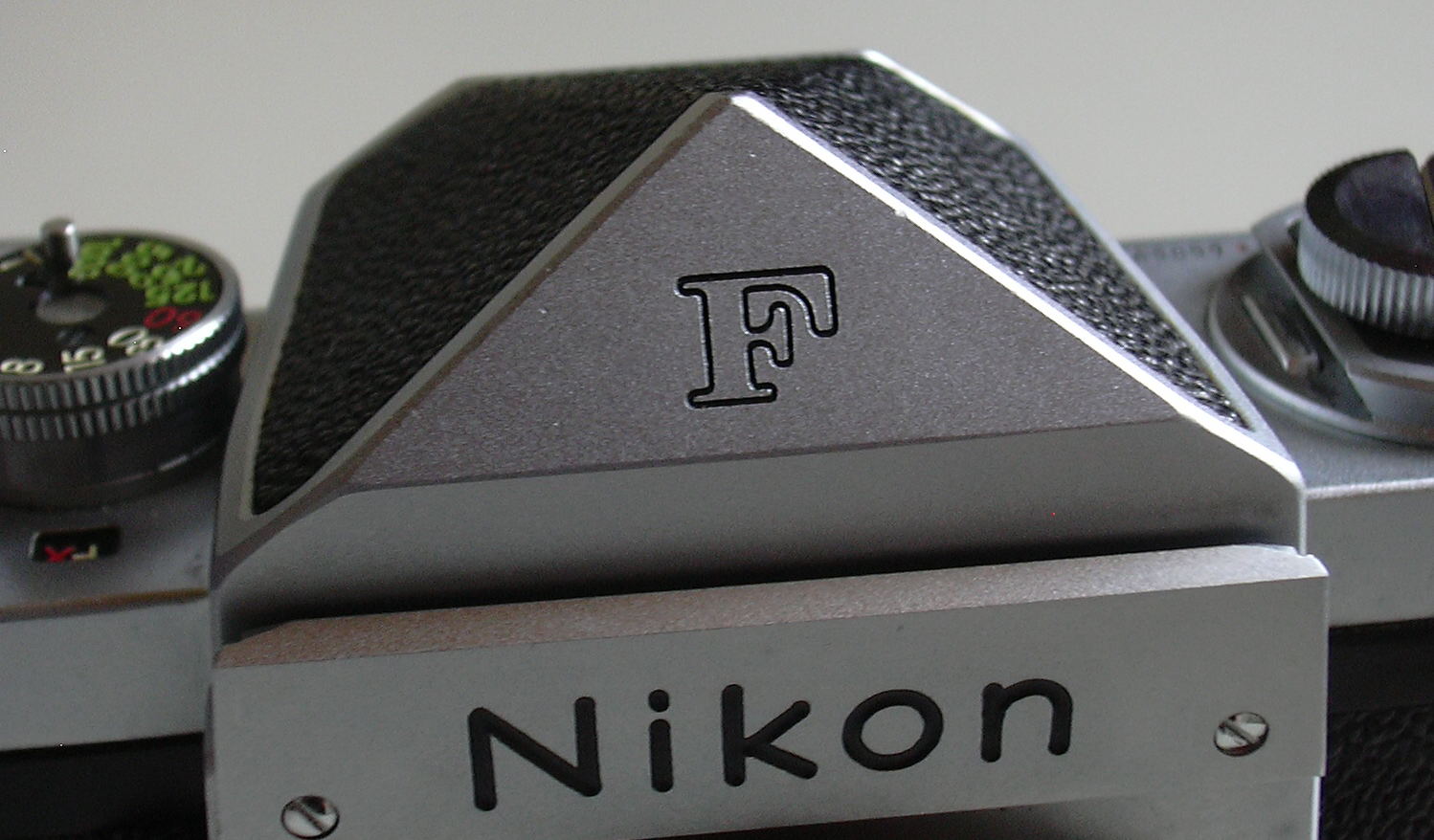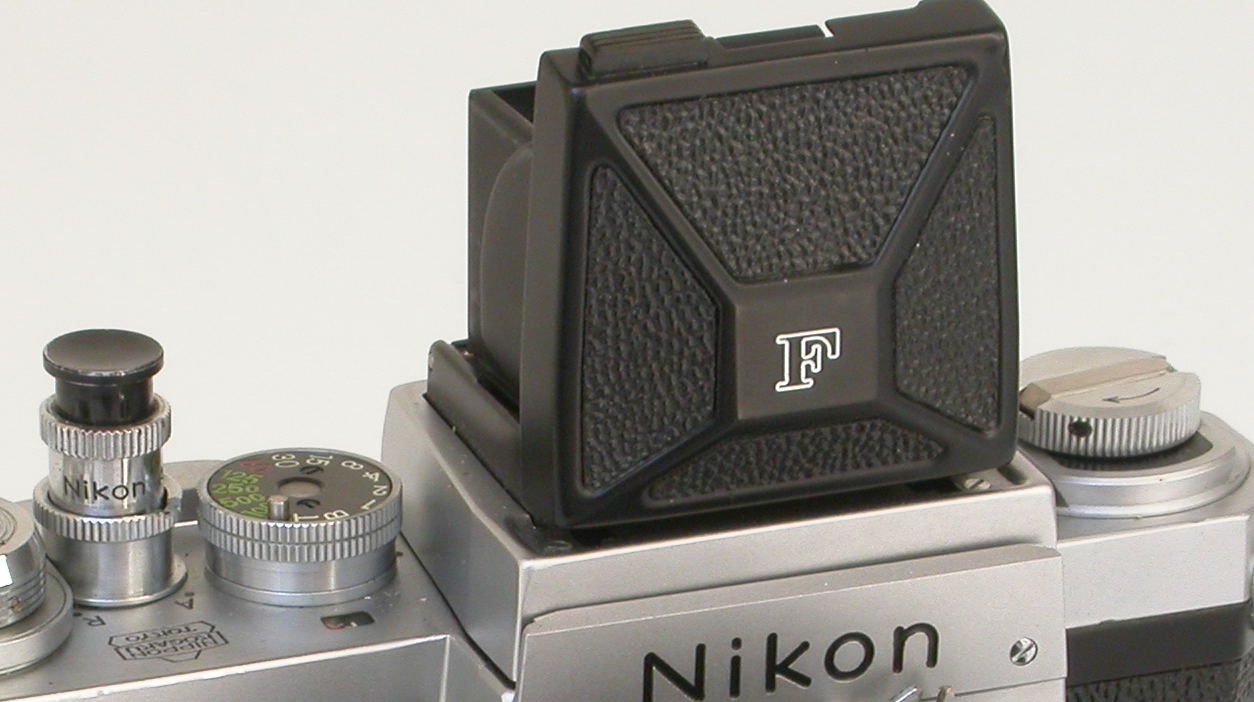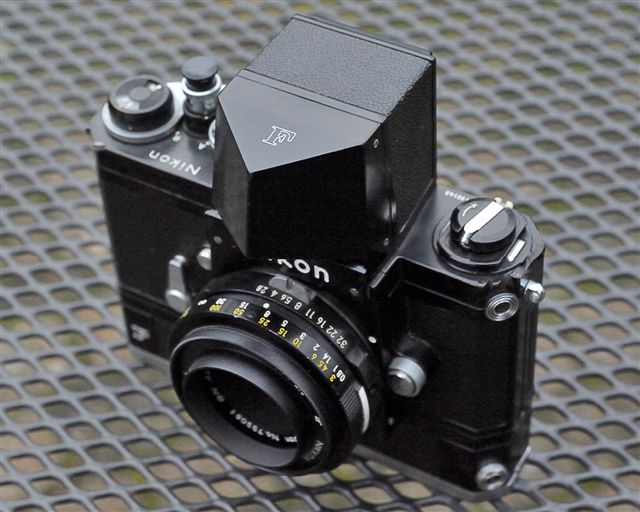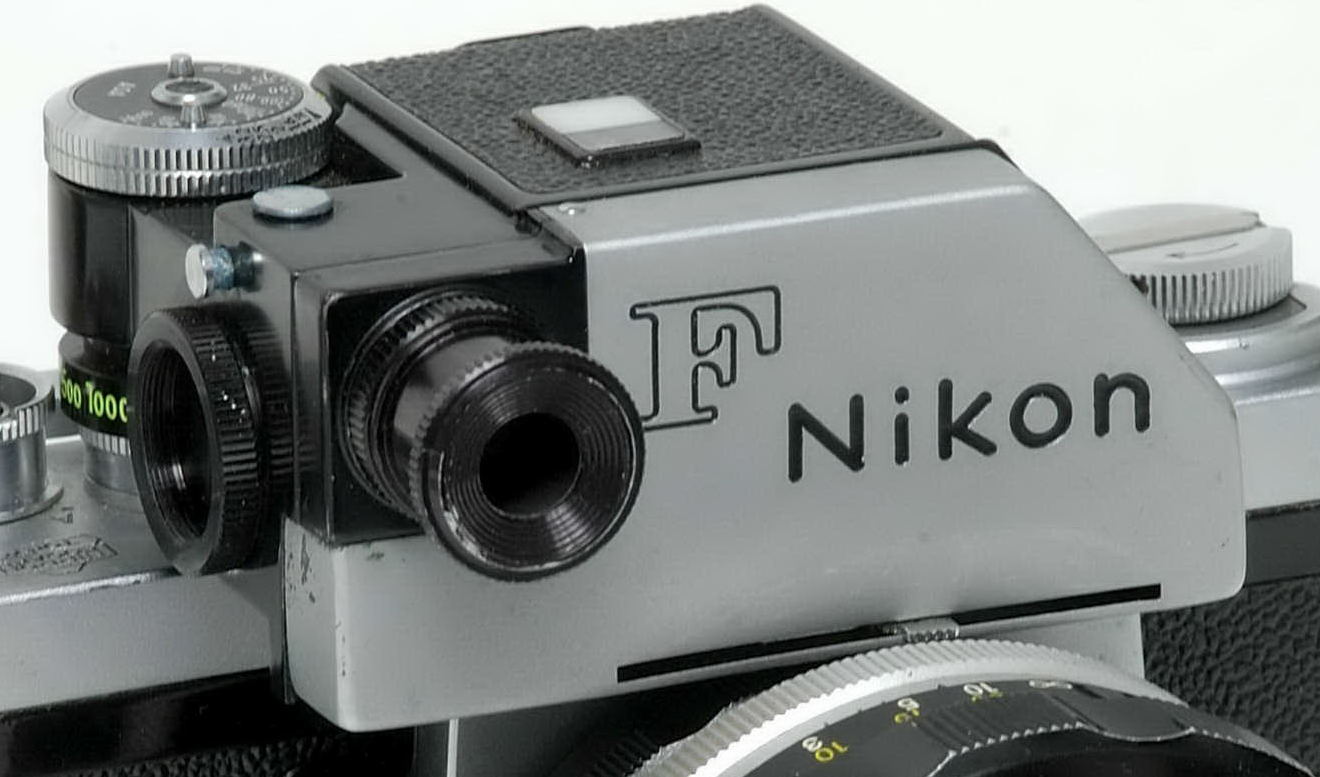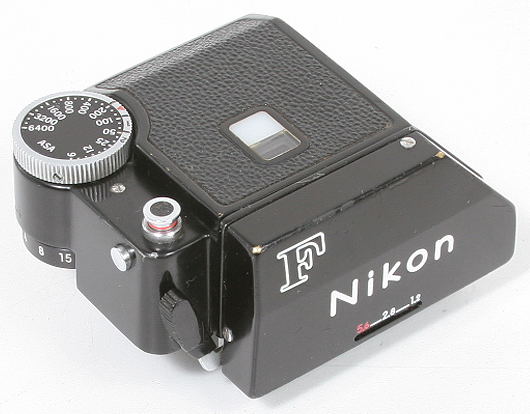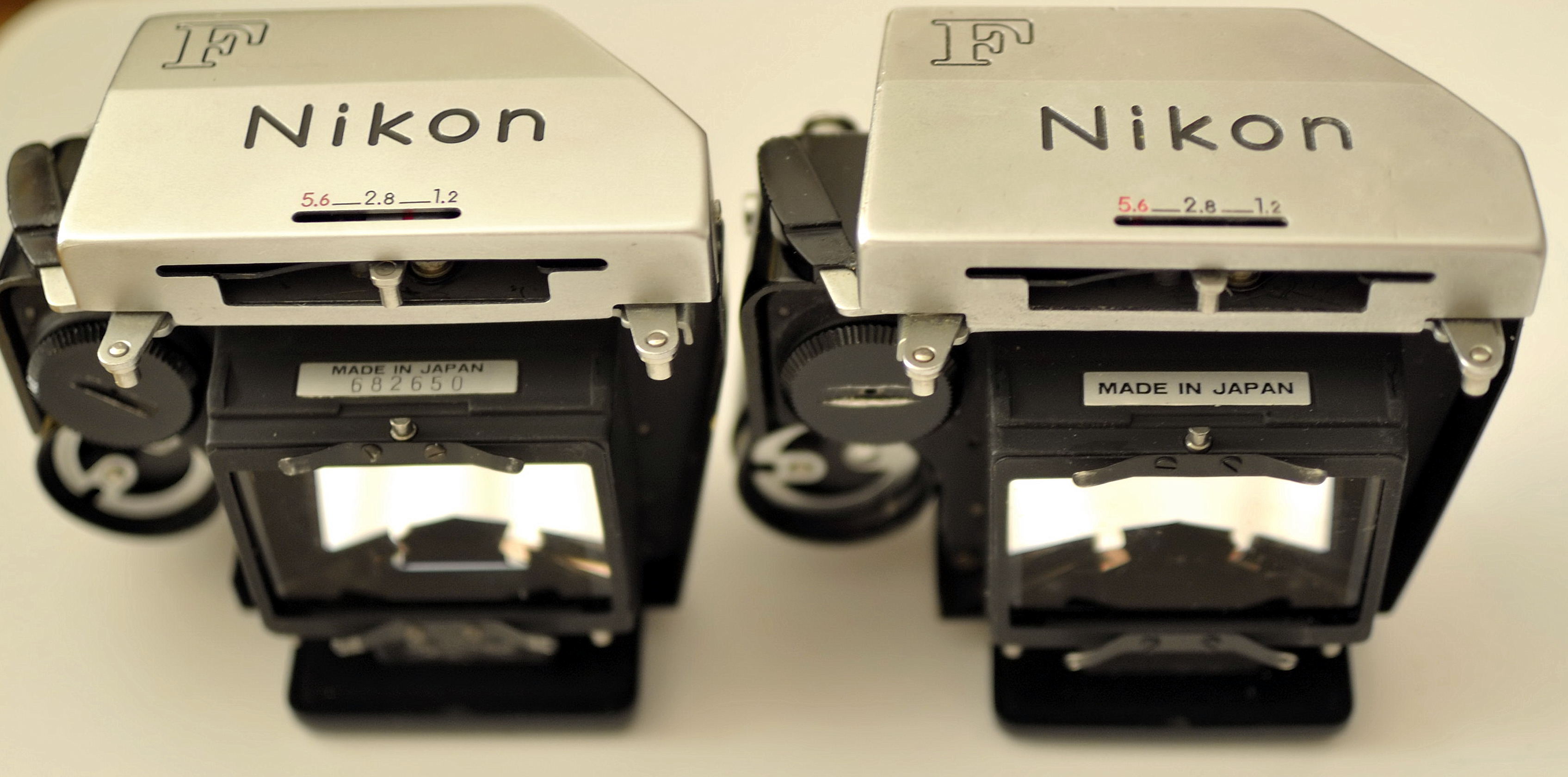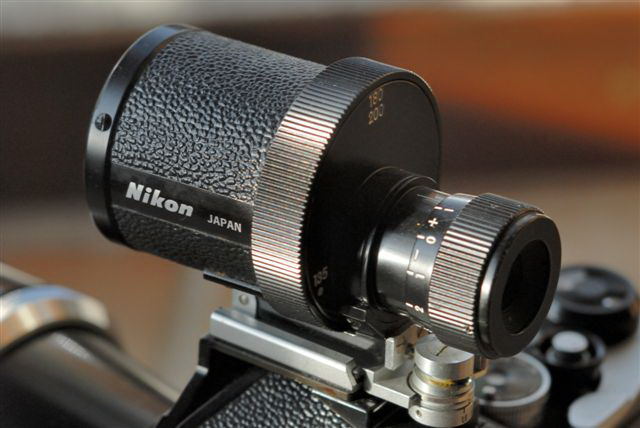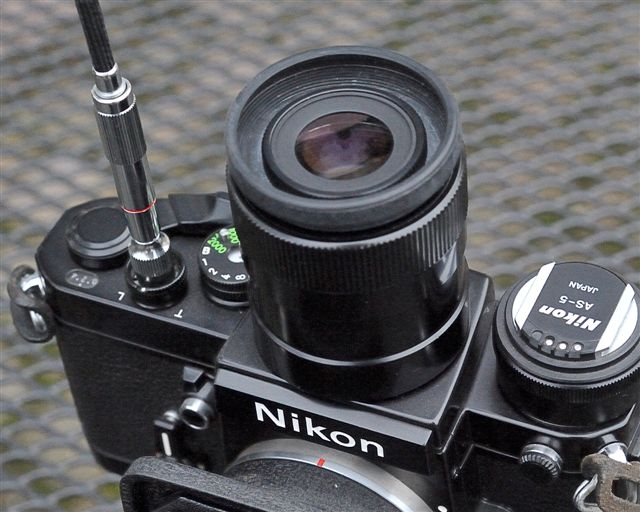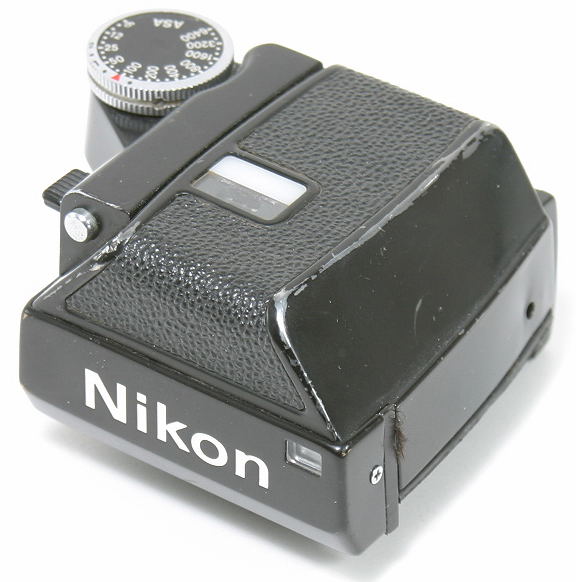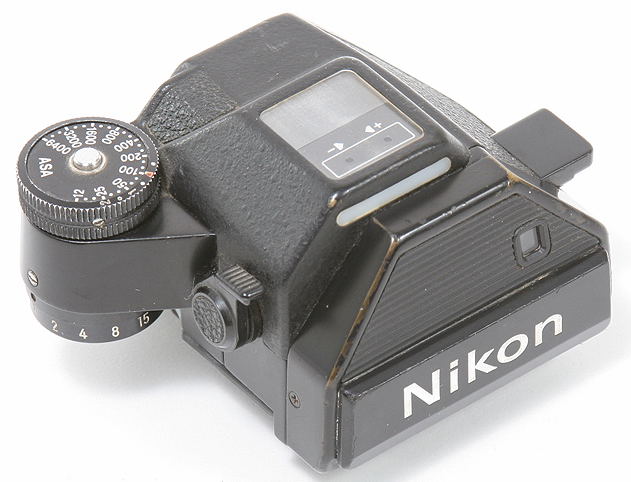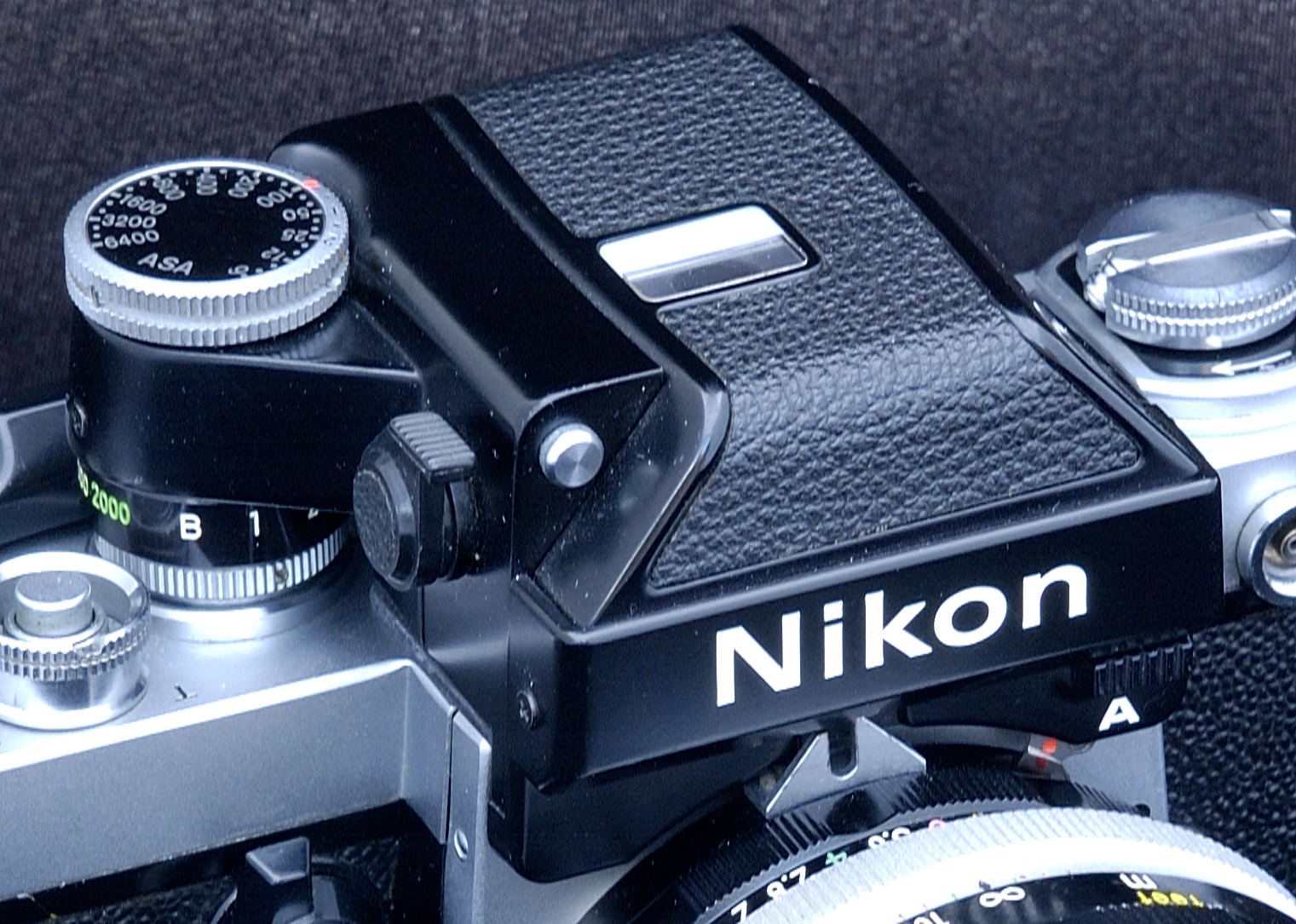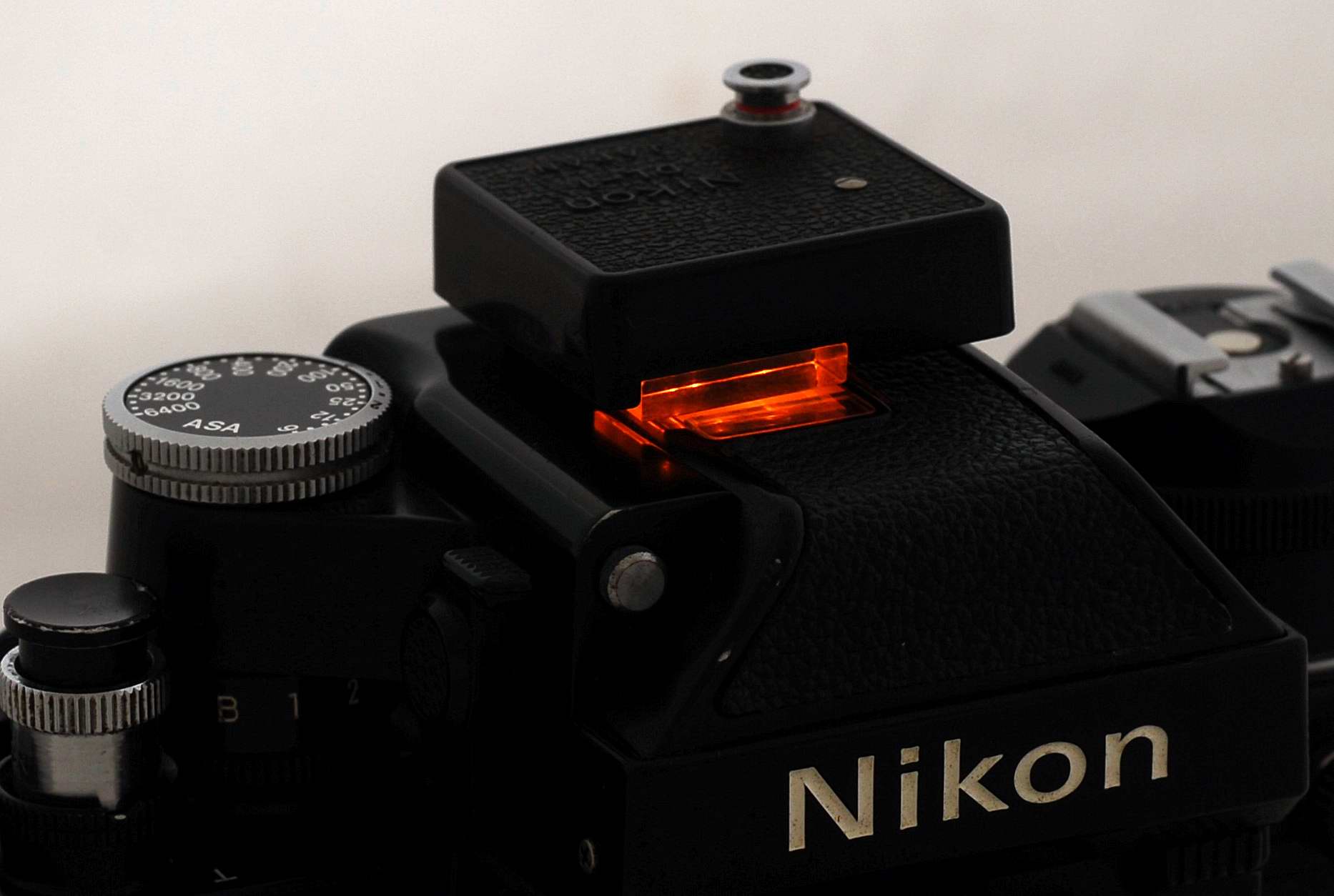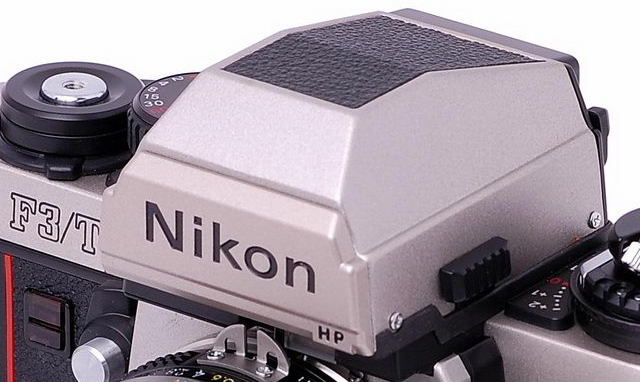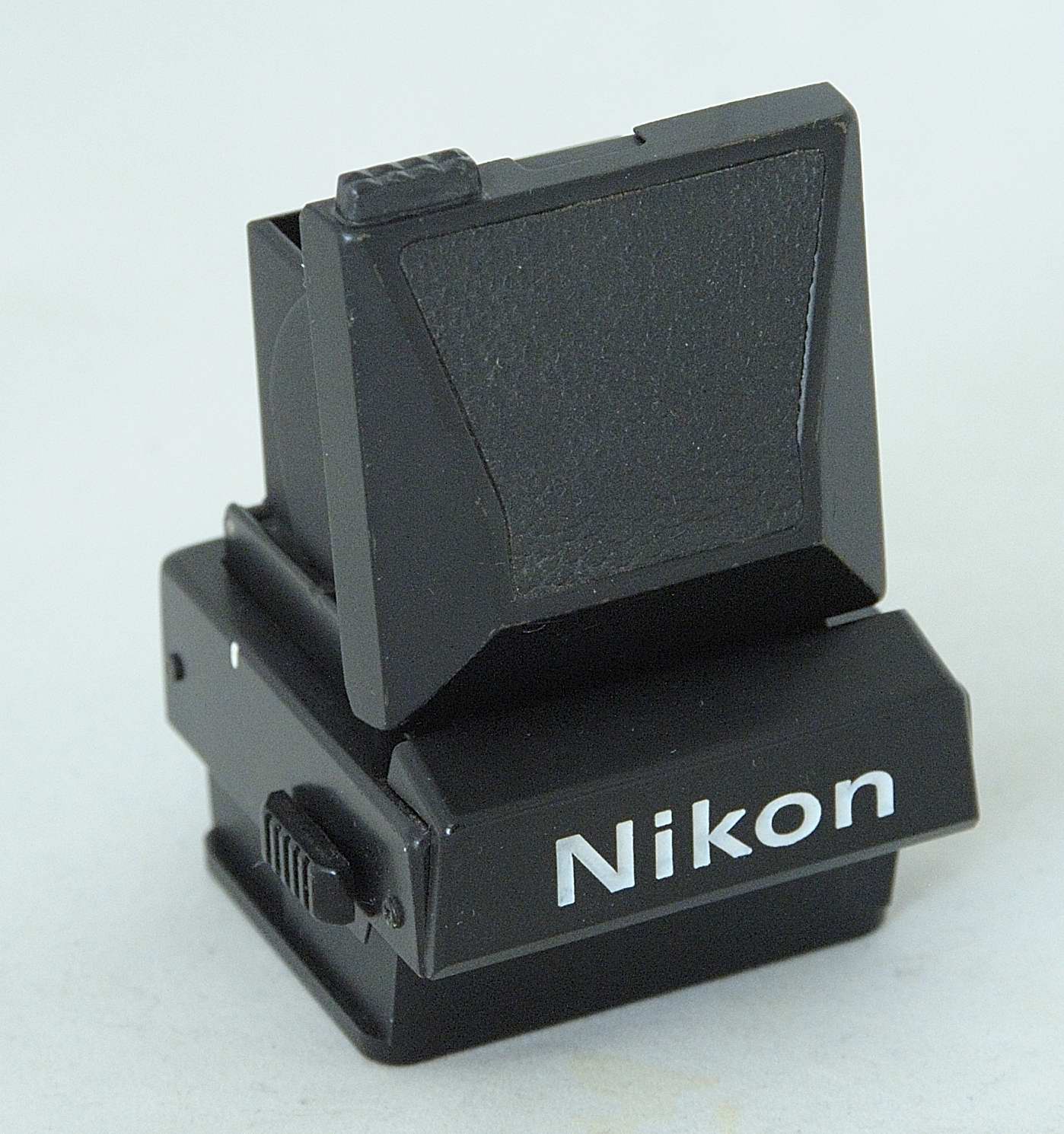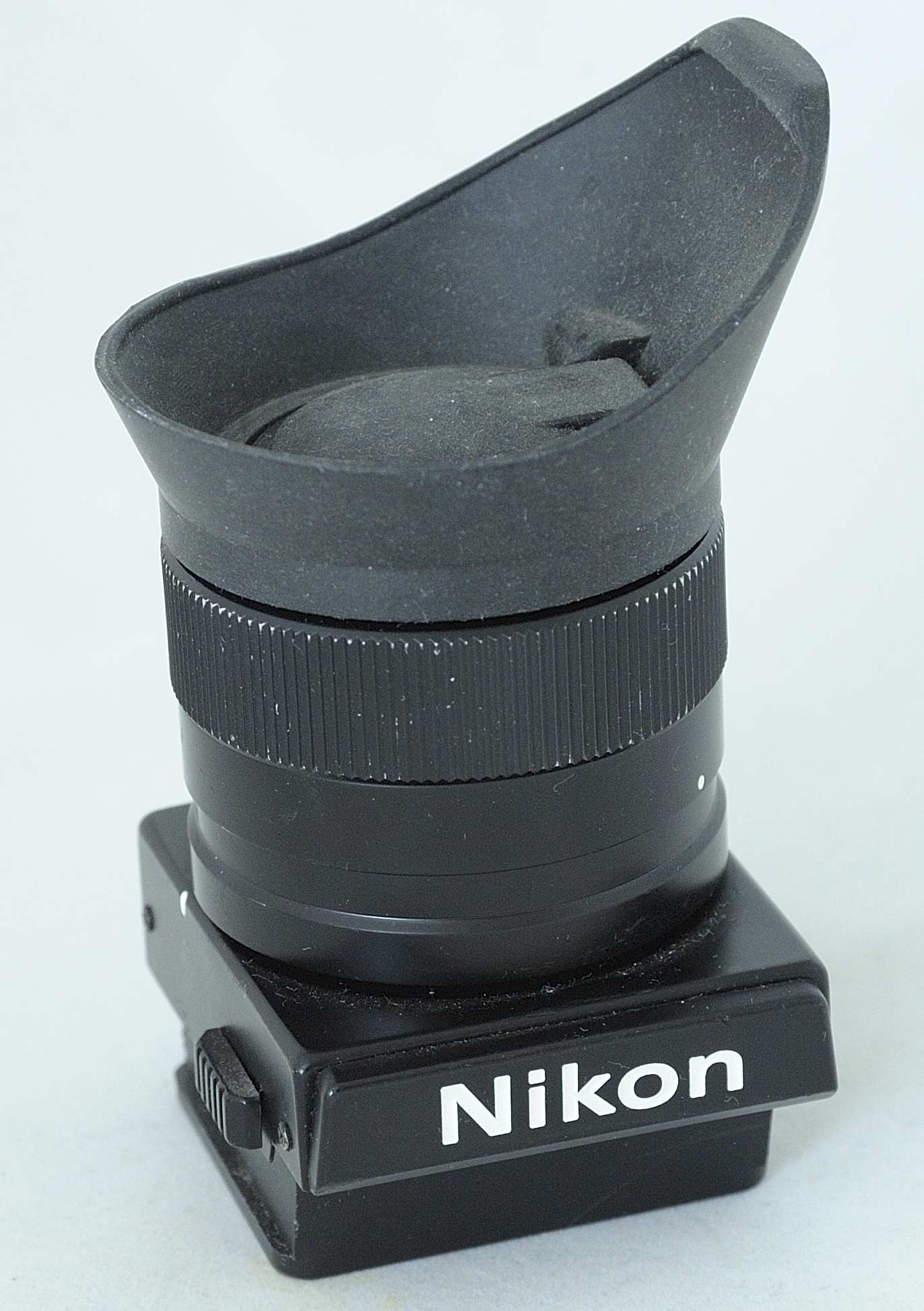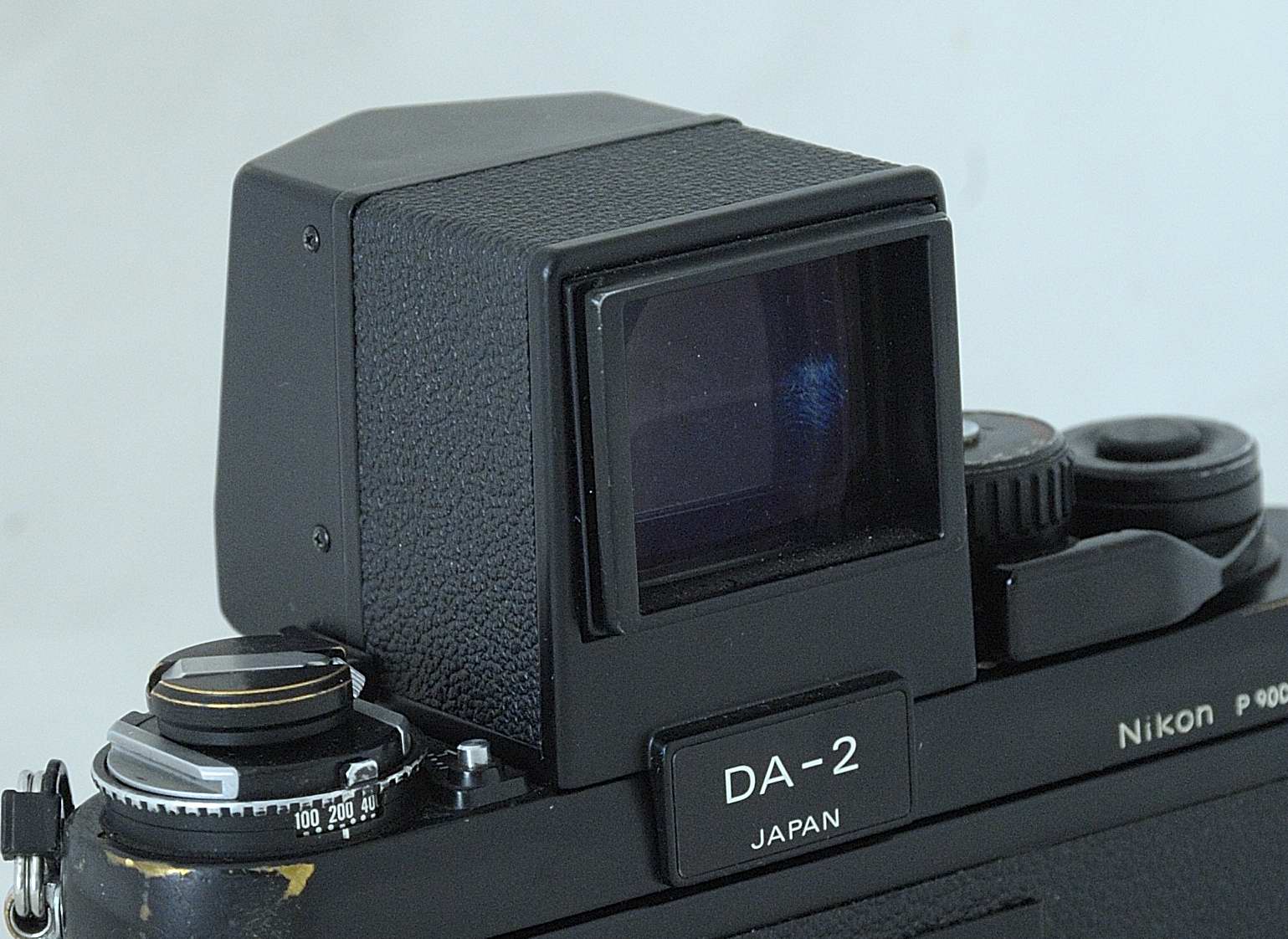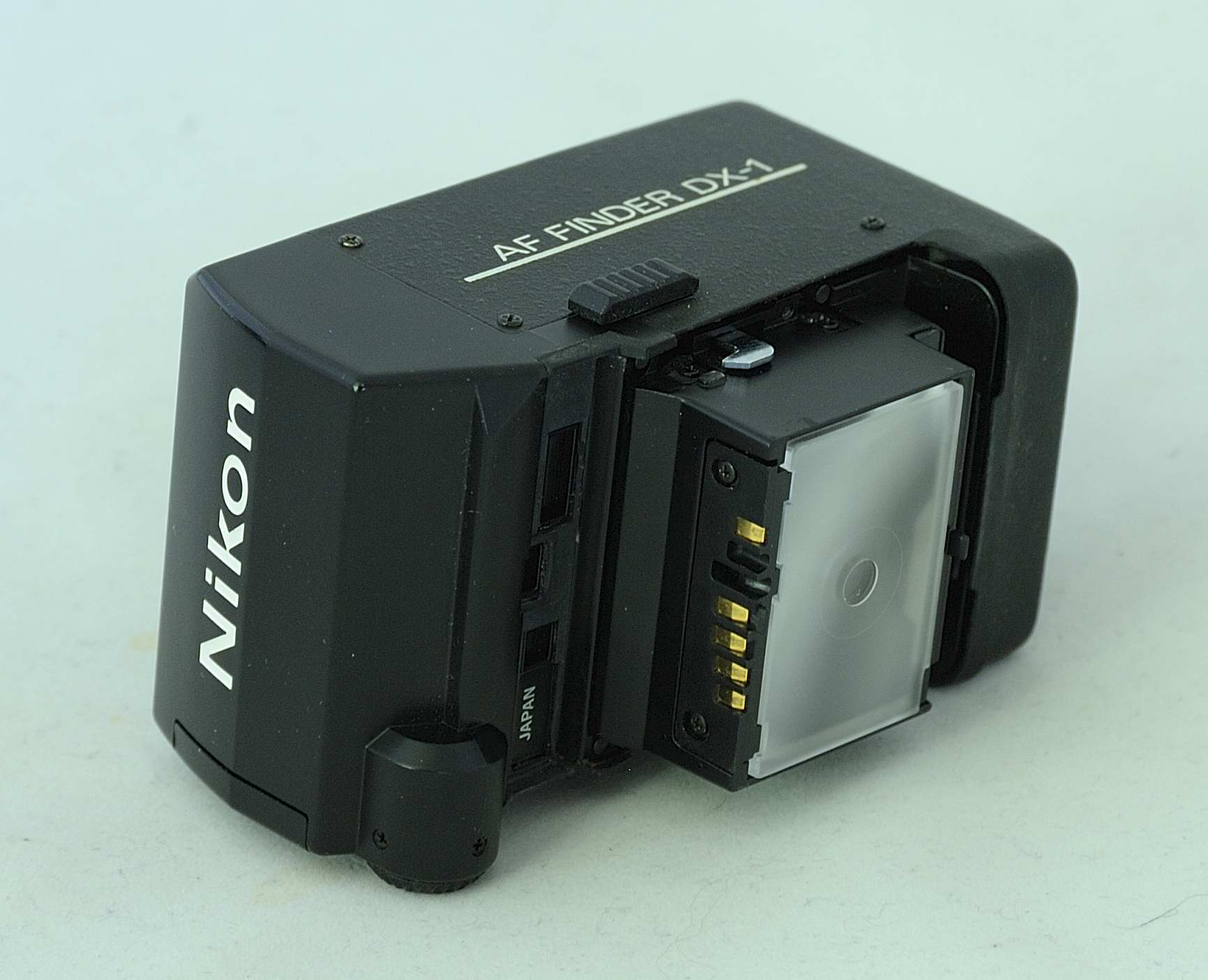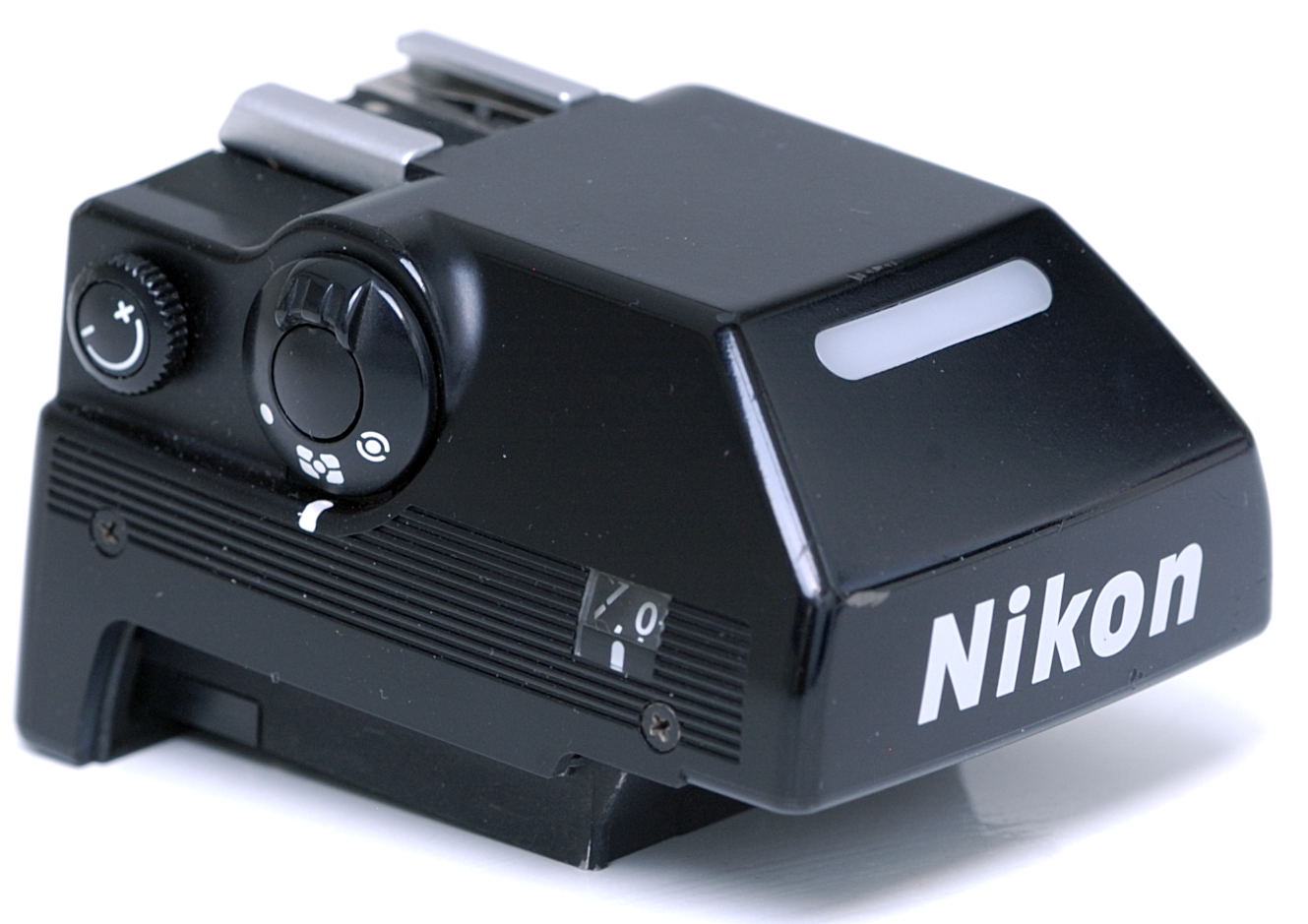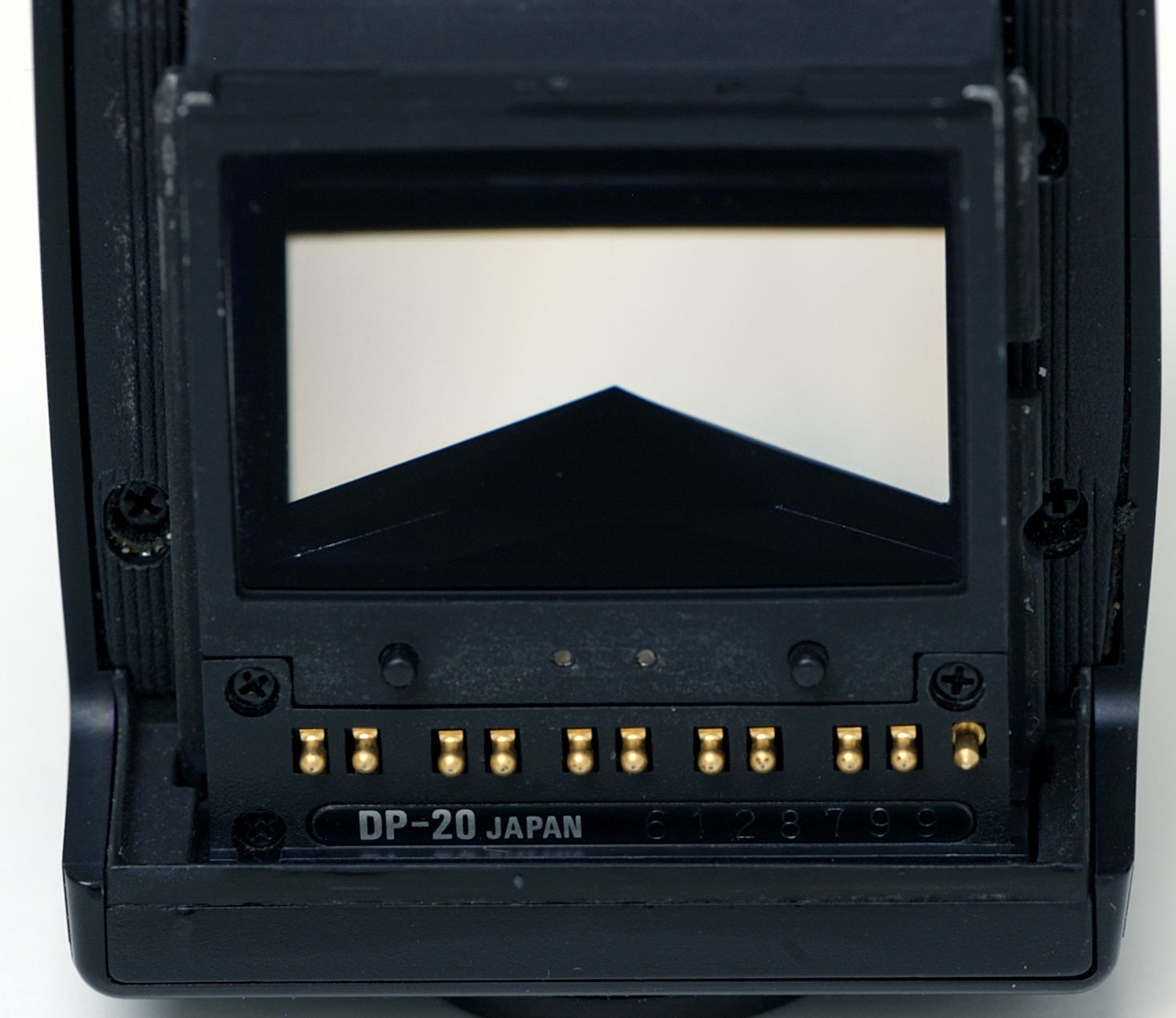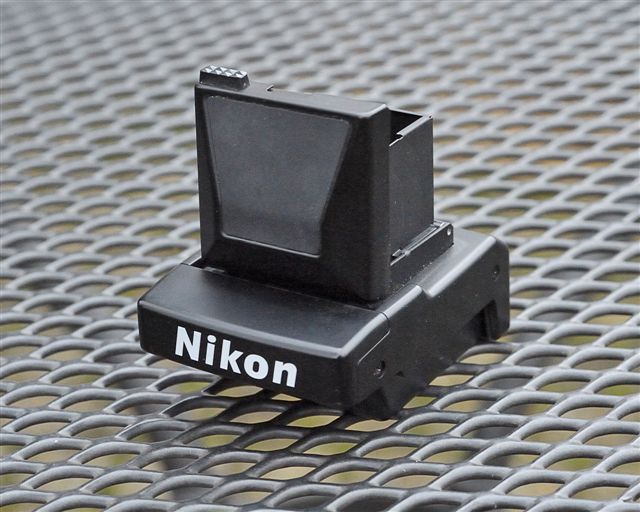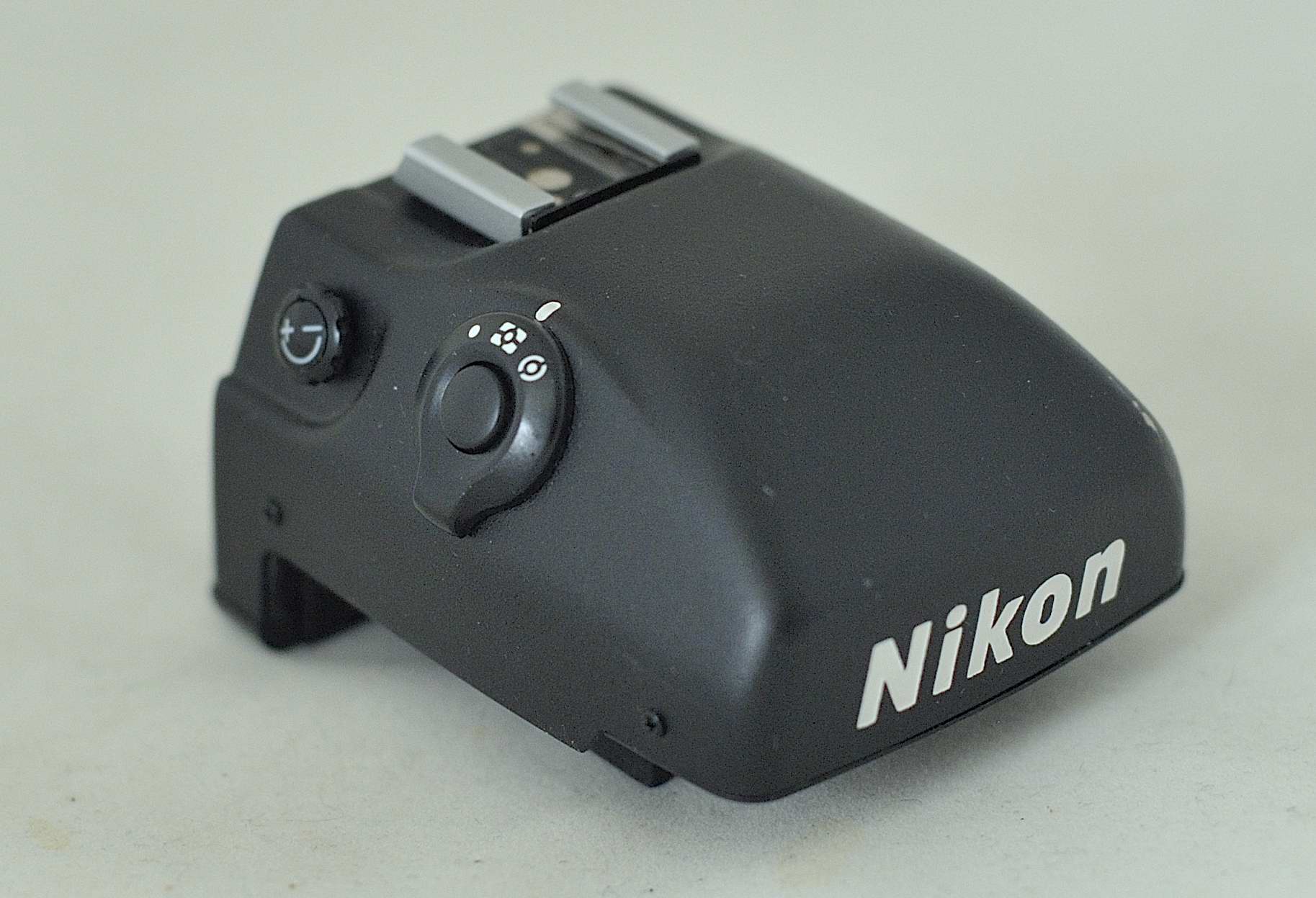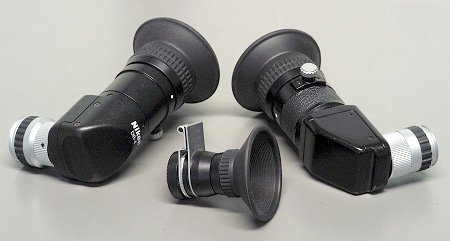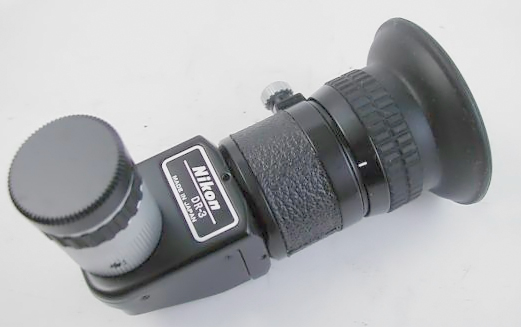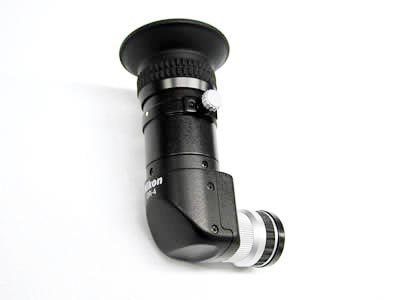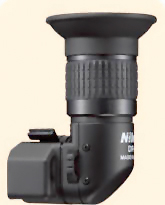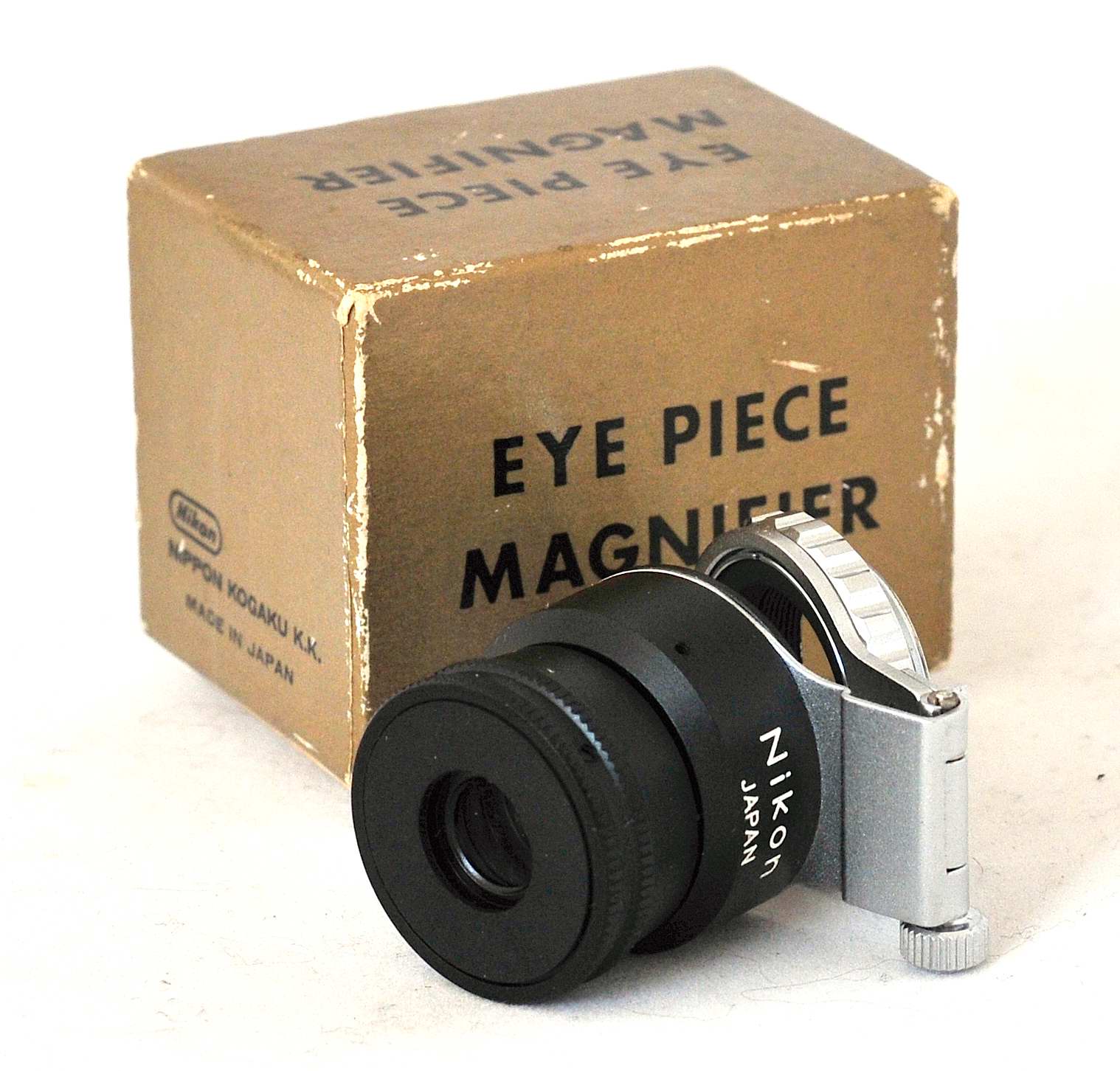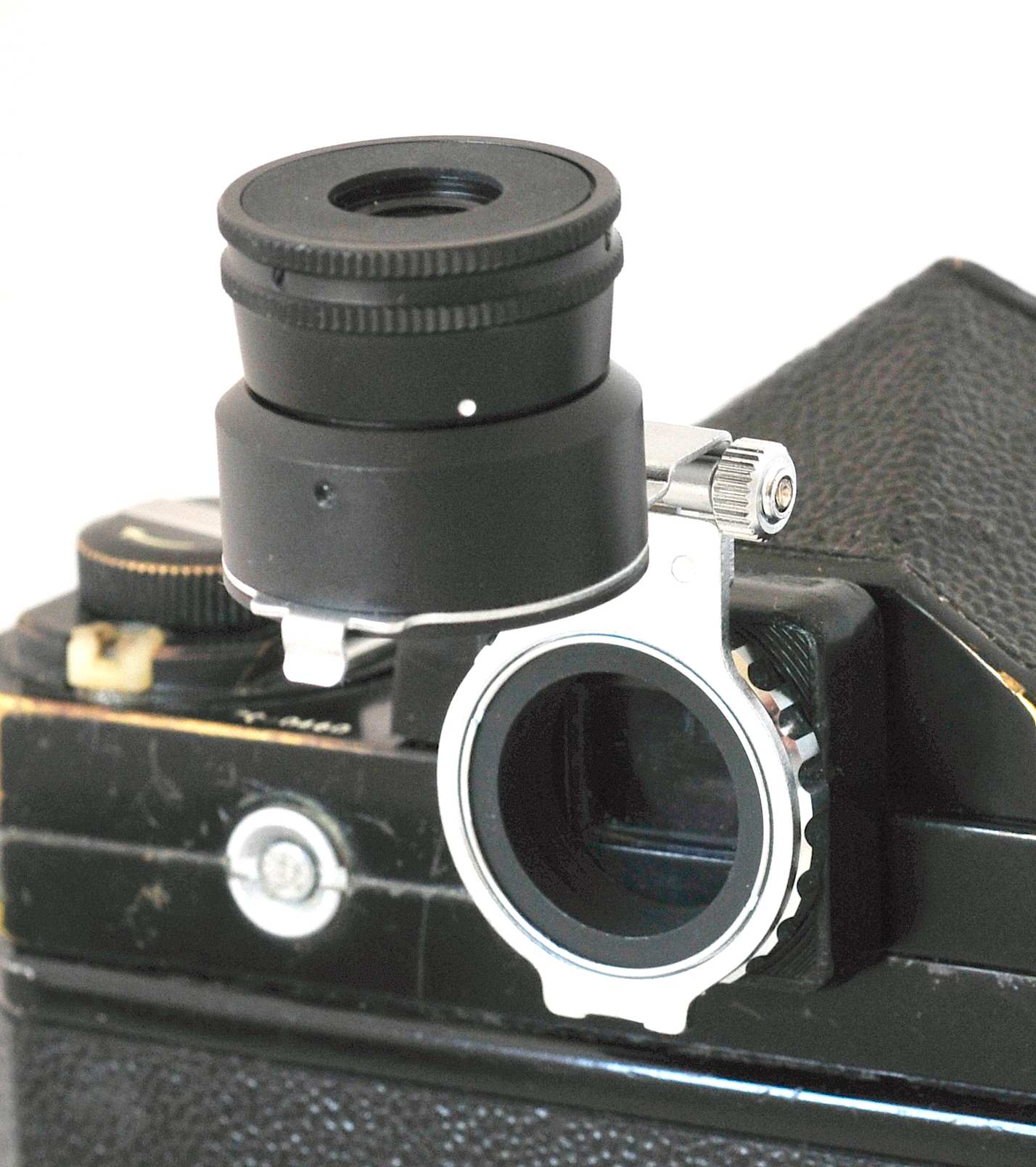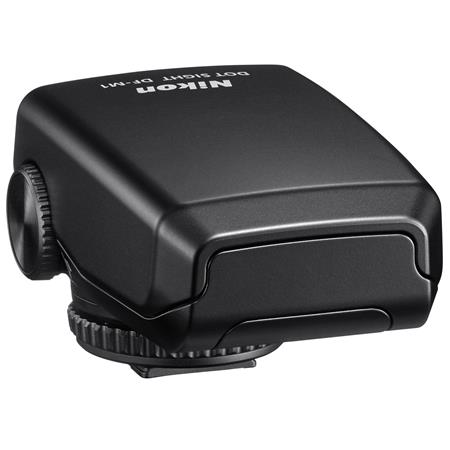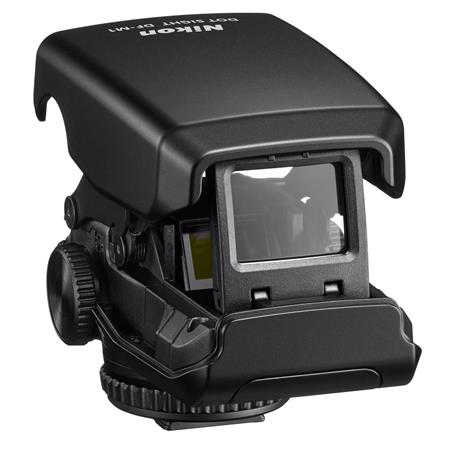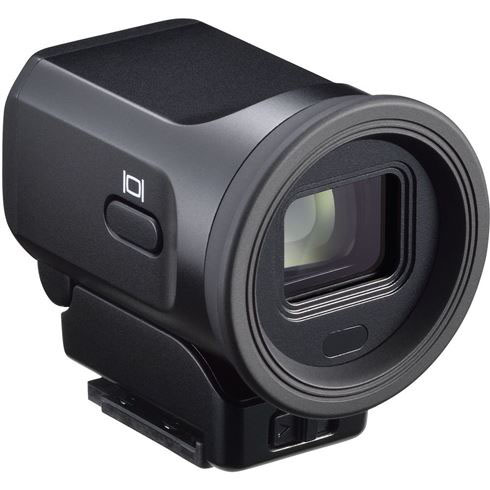Nikon Viewfinders
Eyelevel finder for Nikon F
As stated in the chapter dealing with Nikon´s single lens reflex cameras, Nikon professional reflex film cameras are part of a sophisticated camera system. The Nikon F, F2, F3, F4 and F5 have each a camera body which can be ´dressed´ with a viewfinder, a battery pack, a motor drive, a film or a digital back, etc. In this chapter the viewfinders made by Nikon for the cameras mentioned above are listed. The Nikon F6 is also produced to meet the requirements of the professional photographer, but this camera does not have an exchangeable viewfinder. All other Nikon SLR cameras do not have exchangeable viewfinders, too. Nikon didn´t give a special number or designation to the viewfinders for the Nikon F. Most of the following viewfinders did - however - receive a serial number. Some viewfinders (and viewfinder focusing screens) of the Nikon F and Nikon F2 are interchangeable. E.g.: by removing the nameplate on the Nikon F the DE-1 will fit. Nearly all viewfinders cover virtually 100 % of the picture field and most of the viewfinders with a built-in prism will accept eyepiece correction lenses, eyepiece magnifiers, eye cups and other accessories. Finally all viewfinders were offered in black, although for the Nikon F and Nikon F3 most finders were offered in chrome as well. For special models, like the titanium or anniversary versions of certain cameras viewfinders received the corresponding color.
Note: Viewfinders for the various Nikon rangefinder cameras are reviewed here. Nikon viewfinder accessories are listed here Right-angle finders and magnifier are reviewed below.
Nikon FEye level - waist level - sport - Photomic-series The eye level finder (see above) of the Nikon F, available in chrome and black, can be used for common photography. The image is bright, erect and unreversed. Exposure metering has to be done with an external exposure meter. The very first version has a square viewing point that requires an adapter if lenses or other accessories have to be attached. A second version has a round viewing port.
The waist level finder is useful in macro photography and copying work. It can also be used with the camera overhead or in low position. Like all waist level finders images are erect but reversed. It also has a built-in magnifier (3x). No exposure metering possible. There are two versions of this viewfinder. The first version is a three-sided model, the second (and rarest) version is a four-sided model.
When goggles or protective glasses are used the Action Finder (aka Sportfinder F) can be fitted. Many sports photographers, as well as underwater photographers, are using this view finder because it covers the entire view field very bright, erect and unreversed. One can hold the eye at 60 mm. from the eyepiece. No exposure metering possible. A nice action finder in black has become very rare and sought after by collectors!
The Photomic-series consist of 4 models. The first Nikon F metered prism was the Photomic Prism. It combines the basics of the eye level prism with an external meter using a CdS (cadmium sulfide) cell. This metered prism is coupled to the shutter speed dial and aperture ring. Correct exposure is set by centering the meter needle in the viewfinder and on the back topside of the prism. Be aware of the fact that this meter does not meter Through The Lens (TTL), but via an ´eye´ near the top. Depending on the lens in use and the lightning conditions a Light Acceptance Converter Tube and/or Incident Light Opal Plate (both nowadays very rare accessories) were provided. In 1965 this prism was replaced by the Photomic T, which provides TTL-metering by two built-in CdS cells fitted with condenser lenses to avoid back light entering from the eyepiece. Via turning either the shutter speed selector or the aperture ring of the lens in use a match-needle system indicates the right exposure. This finder was replaced by the Photomic Tn in 1967. This is Nikon´s first metered prism with a center-weighted exposure metering. Up to this point all Photomic finders required that the maximum lens aperture to be manually matched to the ASA dial on the prism to obtain the correct exposure. To maintain proper indexing this must be changed each time a lens is attached.
The last prism finder version for the Nikon F was introduced in 1968: Photomic FTn. It has a semi-automatic maximum aperture indexing by mounting each lens with its aperture set at f/5.6 and than turning it to the full left and full right. New was also the exposure compensation dial and the display of the shutter speed setting inside the viewfinder!
Two versions exist: one with and one without a serialnumber
A rare finder which can be placed both on the Nikon F and the Nikon F2 is the 6x Magnifier viewfinder. It looks like the DW-2, but an original Nikon F version exists.
Above a very rare finder, especially made for the Nikon F High Speed camera, enabling the photographer to see the object while the mirror is locked up. Four viewing angles, representing 4 focal lengths, can be chosen: 135, 180, 200 and 300 mm. Nikon F2DE-1 - DW-1 - DW-2 - DP-1 - DP-2 - DP-3 - DP-11 - DP-12 - DA-1 The eye level view finder DE-1, released with the Nikon F2 in 1972, is a pentaprism finder covering 100 % of the picture and it has a ready-light built-in for flash photography (when a flash is connected to the electrical post on the back left side). For the titanium version of the Nikon F2 (introduced in 1976) a special DE-1T with a titanium top was provided. The DW-1 waist-level finder is meant for use at waist-level and overhead or copying work. It is provided with a pop-open type hood and a fold-away magnifier.
The DW-2 is a 6x magnifier viewfinder with a built-in diopter that has to be customized by focusing on the rangefinder split on the ground glass of the viewing screen before it can be used to focus on a subject. The DA-1 is an updated version of the Nikon F Sportfinder. The Nikon DP finders are all TTL exposure metering prisms. They were all supplied in chrome and black.
The DP-1 has two CdS cells for accurate center-weighted exposure metering. The meter needle, shutter speed and f/stop appears inside the viewfinder, as well as a ready-light when a Nikon Speedlight is in use.
DP-2 has more or less the same features as the DP-1. Its main new feature is the display of diodes that display the over- and/or under-exposure in the viewfinder display and on the top of the prism. The CdS cells are a bit more sensitive thus having a wider EV-range and the ability to meter down to 8 seconds. DP-3 - introduced in 1976 - has SPD cells (SPD = silicon photo diodes aka silicon blue cells). The cells are coupled with a five-stage LED display (plus, circle and minus sign) to indicate correct exposure. The DP-3 also has an eyepiece curtain which can be closed to prevent stray light entering the prism and influencing exposure metering. The DP-3 can work with the DS-1 and DS-2 aperture control unit, converting the Nikon F2 into a semi-automatic camera with shutter priority setting.
DP-11 is an exact copy of the DP-1 but with Nikon´s AI (Aperture Indexing) added. At the left front side it carries an 'A'. DP-12 is an updated version of the DP-3 with AI-coupling. This viewfinder carries an 'AS' at the left front side.
DL-1 is a cute little light on top of the viewfinder to view the exposure meter of the DP's in dark light. It is fastened via the viewfinder's eye piece.
Nikon F3DE-2 - DE-3 - DE4 - DE-5 - DW-3 - DW-4 - DA-2 - DX-1 The Nikon F3 (featuring built-in exposure metering) could be ordered with the standard eye level viewfinder, named the DE-2. It has a very clear view of 100 % of the picture. Its magnification is much better than any other finder for the Nikon F3. Nevertheless it was replaced by the DE-3 High-Eye point Finder in 1982. This view has a larger diameter eyepiece and a greater eye relief for those wearing glasses or not. Dead-center at the top of the viewfinder is the Aperture Direct Readout window displaying the f/stop in use. Next to it on the right is the flash diode and to the left is the LCD (liquid crystal display) window, showing the shutter speed.
The DE-4 (see above) is an exact copy of the DE-3 but with a titanium top. This viewfinder came on a Nikon F3/T, in titanium color (aka champagne) or painted in black. The DE-5 is a special finder for the Nikon F3P. It has an ISO hot shoe on top and electrical contacts (for flash photography) inside the rear back. The latter feature will only work when fitted to a Nikon F3P. All DE viewfinders have a tiny and very fragile lamp built-in to illuminate the LCD-screen. On the right front there is a little red button which should be pressed. This lamp is the first item on a Nikon F3 that gives up the ghost.
The DW-3 (above) is a waist-level viewfinder like they were supplied for the Nikon F and Nikon F2.
The DW-4 (above) has a 6x magnifying tube on top (+ closable rubber cup), showing the subject reversed.
For sport photographers Nikon made an action viewfinder, similar to those for the Nikon F and F2, the DA-2. This huge viewfinder enables the photographer to see a bright picture and both the shutter speed and aperture from a distance up to 8 cm.
The DX-1 is a special viewfinder - with integrated screen - that only fits and works with the Nikon F3AF. Auto focus photography is only possible with the two lenses, especially designed for this camera set. For more details please see the Nikon F3 chapter.
Nikon F4DP-20 - DW-20 - DW-21 - DA-20
The first ´Multi-Meter-Finder´ for the Nikon F4 was the DP-20 (see above). This prism has a built-in metering system with three different exposure metering modes (to be set by an external switch on the side): center-weighted, matrix-metering and spot-metering. In fact this viewfinder is a little computer, having 4 integrated circuits (IC), including an 8-bit microcomputer. It has a diopter adjustment (-5 - +4) and some electrical contacts for flash photography when a flash is placed on the hot shoe on top. If focusing screens are used with a different transparency the exposure meter can be corrected via a screw on the right front side. This viewfinder came with a special screwdriver for this adjustment. The adjustment can be viewed in a little window next to the screw.
The DW-20 (see above) is a classic waist-level finder (reversed image!) with a pop-up 5x magnifier loupe as part of the hood. It has a socket to accept the SC-24 cord. The DW-20 has no metering system built in, so only spot metering is available. The DW-21 High-Magnification Finder permits viewing straight down from above the Nikon F4. Like with the DW-20 only spot metering is possible. It has no hot shoe, but a socket for the SC-24 cord. The huge DA-20 Action Finder (aka Sportfinder) provides center-weighted and spot metering which can be set with a switch on the side of the prism. This finder with TV-alike screen has an ISO TTL-hot shoe on top. The huge eyecup should be used always as the built-in metering cells can be affected by light coming in from the finders eyepiece.
Nikon F5DP-30 - DW-30 - DW-31 - DA-30
The viewfinders that were offered for the Nikon F5 are similar to those made for the Nikon F4. The DP-30 (see above) has a built-in computer including many exposure metering modes as well as diopter adjustment, an eyepiece curtain and an ISO hot shoe on top. The DW-30 is a classic waist-level finder, the DW-31 a 6x high-magnification finder and the DA-30 an action finder, all alike the corresponding finders (and their features) used for the Nikon F4. Only the DP-30 has all metering features, the DW-30 and DW-31 have no metering at all (which is done inside the F5 body), but the DA-30 has spot metering, center and matrix metering but not the 3D colour metering. There is a special version of the DP-30: the ´DP-30 50 years´ that came with the Nikon F-5 50 years commemorating Nikon´s start of its SLR production in 1959.
Nikon right-angle finders
When using a repro-stand on which a camera is placed horizontally Nikon provided right-angle finders - with a viewing angle of 90° - for various single lens reflex cameras. Those finders received the DR-code.
Most of them can be placed directly on the viewfinder, some will need an additional adapter. All right-angle finders are offering an individual eyesight adjustment with built-in diopter (-5 to +3)
Nikon did not supply right-angle finders for the Nikon rangefinder cameras, as these cameras will need a reflex housing (offering a 90° view) when used on a repro-unit. Nikon DR-1 (does not exist!) The very first right-angle finder for the Nikon F-series does not have a code! It can be screwed (19 mm. thread) onto the viewfinder. Before doing so it is advisable to set the ocular lens (diopter -5 to +3). A second model has a better grip. It will fit most SLR cameras, for some Nikon view finders an adapter is available. Both models have a mirror image or reversed view.
Nikon DR-2 This successor of the first version has a prism and 7 elements. Image is now unreversed and is covering 100 %, when used on the Nikon F and Nikon F2 camera series. It is possible to move this finder 360°. When used on certain Nikon SLR cameras the viewfinder ocular lens (Nikon FM/FE-series) and the tube with rubber ring (Nikkormat-series) has to be removed first.
Nikon DR-3
This right-angle finder is an improved DR-2. The diopter lens can be locked, it can be moved as well and it will fit all Nikon F and Nikon F2 cameras directly. If used on modern cameras, like the Nikon F100, Nikon F5 etc. a Nikon DK-7 adapter has to be used. From now on all finders received a rubber eyecup.
Nikon DR-4
This finder - with similar specifications as the DR-3 - can be used on the Nikon D1-series. When used on other/older cameras a Nikon DK-13 (19 mm.) adapter is needed.
Nikon DR-5 This right-angle finder has the same features as the finder mentioned before. This finder will fit all Nikon SLR film cameras with a rectangular viewing eyepiece and the Nikon D700 and Nikon D2-series and Nikon D3-series.
Nikon DR-6
This finder will fit the digital reflex cameras, like Nikon D40-series, D50, D60, D70, D80, D90, D200, D300, D3000, D3100 and D7000.
Eyepiece magnifier / DG-2
This eyepiece magnifier (without a code) can be used on a Nikon F and Nikon F2 fitted with a viewfinder with a 19 mm. thread. It offers a 2 x enlargement of the center of the viewfinder image. Diopter can be adjusted from -4 up to +2. A later model, named DG-2, will fit any Nikon F3, Nikon F4 and Nikon F5. Any later introduced camera with the same filter thread on its viewfinder may take this magnifier, too. The DG-2 offers a dioptre range of -5 - +1.
Nikon DF-M1 Dot Sight
This interesting device was introduced together with the Coolpix P1000, for which it was designed. When attached to the hot-shoe it assists you in acquiring distant subjects as a zoomed-out targeting device. It may be used on other cameras as well.
Nikon DF-E1
This electronic OLED viewfinder was announced in June 2016 together with the Nikon DL-series cameras. It has a 2.36k dot resolution. Unfortunately the market introduction of the entire camera series and their accessories was definitively cancelled. |
